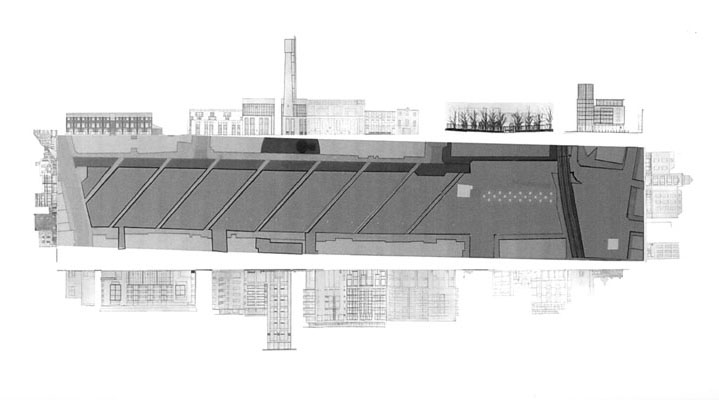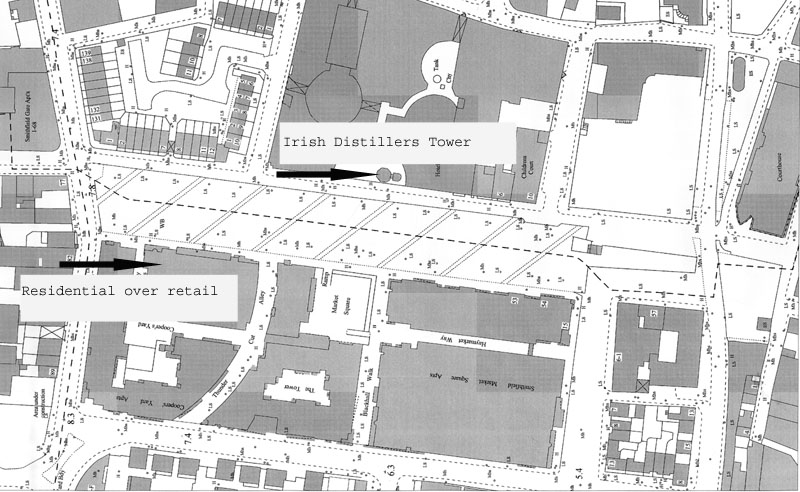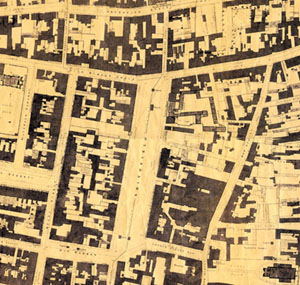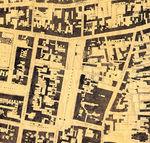Smithfield Square
An old horse market in Dublin, Ireland.
Redeveloped as a public open space as part of the re-generation of the inner city of Dublin
Rationale: Why is this case study interesting?
The site was chosen as a case study for several reasons:
1. The site was once a market square used for trading. Ireland has many towns with centrally located defunct market squares. They are now primarily used as car parks but have obvious potential as civic open spaces. While a small number of these spaces have been redeveloped in the past, Smithfield is a more recent example of this development. There is a huge sink of urban open space in Ireland yet to be tapped.
2. From a planning and development point of view there are some interesting aspects to this development. In the early 1990s the Temple Bar area of Dublin was redeveloped. There are similarities between Temple Bar and Smithfield square prior to redevelopment: both are centrally located sites; both were run down and unfahionable with many derelict buildings; both had alot of natural character. The Temple Bar redevelopment is generally considered a success, giving the area and its surroundings an economic boost. Traditionally the northside of Dublin where Smithfield is located, has been seen as the poor relation to the southside, where Temple Bar is located. The redevelopmaent of Smithfield was a step towards redressing this imbalance and giving that part of inner city Dublin a much needed boost.
3. An international design competition was held for the design of the square. This is a very early example of a design competition for a public open space in this country.
Author's perspective
- What theoretical or professional perspective do you bring to the case study?
The redevelopment of the square is one part of a larger regeneration scheme; the Historic Area Regeneration Project. As a student of Landscape Architecture I would like to examine the success of the square and its contribution to the overall regeneration scheme.
Landscape and/or urban context
- Biogeography, cultural features, overall character, history and dynamics
Illustration: Map; sketches; short descriptive analyses
Cultural Features: To the north, Georgian period houses face on to the square. The Irish Distillers building is set back from the eastern edge of the square. Its thirty eight metre high chimney stack is a dominant visual element. Further to the east is the old markets area, while the Four Courts lie to the south.
Smithfield building edges plan/elevation, courtesy of 2nd/3rd Larc 2007/2008 acadenic year, UCD
Overall Character: The new design maintains the open aspect of the old market. The original cobble stones have been re-laid, this along with the surrounding urban fabric gives the site a historic feel. However the square lacks coherence due to the different conditions and styles of the surrounding buildings.
History and Dynamics: Smithfield Square is located in a historic area of Dublin, on the outer edge of the city centre. The area has been traditionally unfashionable, with much commercial and industrial development.
Cultural/social/political context
- Brief explanation of culture, political economy, legal framework
The surrounding area is dominated by:
The markets area. This area has historic market buildings, unsociable working hours and alot of activity, with loads coming in at all hours. Early drinking houses have a long association with this area.
Housing. The housing in the area is largely made up of social housing. The older units are small two storey terrace houses. To the north of the the site there are medium sized blocks of social housing.
The Four Courts. This is the largest courts complex in the country. There is a lot of movement associated with it, from court employees and the legal profession to the transport of prisoners.
The inhabitants of this area have traditionally been working class, over the past ten or so years many immigants have made this area their home.
The administration and development of the area is the remit of Dublin City Council. Illustration: Bullet points, image, background notes
History
- How did the area/project/plan at the focus of the case study evolve?
Illustration: Table or time line
The space was developedas a cattle market in the seventeenth century. An existing river, the Bradoge, was channelled underground and still runs beneath the site today. The cattle market was moved from the square in 1863, leading to a decline in the area, thuogh it still functioned as a market, selling hay, up to 1972. With the world wide recession of the late 1970s and 1980s the whole area degenerated, with many buildings becoming derelict. The Square was then used as a surface car park. In 1995 Dublin City Council initiated the Historic Area Rejuvenation Plan.
Spatial analysis of area/project/plan
- What are the main structural features?
- How has it been shaped? Were there any critical decisions?
Illustration: Map/diagram/sketches photos and background notes
The space is defined by the building outlines. The large apartment building on the west side along with the lamp standards give a feeling of spatial disharmony and create an atmosphere of foreboding.
The area possesses a maze of small streets with a range of building heights giving a sense of inclosure. The Square is an oasis of open space amongst this street pattern.
Core questions working group open spaces
How does the design of an open space contribute to a run down neighbourhood?
Development of an open space is a tool often used to bring investment into a run down area by generating interest in developers, seeking development opportunities. There are a number of factors required to make this work. One of these factors is good design. If the space is designed well it will attract people to it, creating economic interest in the area. Of course it is not only economics that contribute to a run down neighbourhood, though economics are important. A good design can give or add to the sense of place in a neighbourhood, generating pride in the area and fostering community spirit.
In the case of Smithfield Square there was an initial flurry of development with some residential and retail units built in the first few years after completion of the Square. since then there has not been much in the way of development and there are still some run down buildings at the edge of the Square. This is not entirely down to the design. The location is not popular, being at the edge of the City centre and o little off the beaten track.
How are open spaces linked to the adjacent areas?
(e.g. neighbourhoods, city centre, river)
the old distillery tower provides a visual link to the Square, while the Four Courts (a historical landmark building on the quays) provides a visual reference to the space from the river Liffey.
The tower and the Old Cobblestone pub are tourist links.
Dublins urban rail system, the LUAS passes infront of Smithfield linking it to Connelly railway station, the bus depot and the west of the city.
The is a network of tight streets around the Square which can make it difficult to find for people not used to the area.
The river Liffey passes close to the site. The river itself carries little traffic but the roads either side of the river, referred to as the Quays, are main routes in and out of the city. The Liffey boardwalk stretches from the city centre to a point a short distance from the Square.
There is not much habitat linkage. A stand of mature trees exists on the south side of Smithfield Square. This is quite isolated from any other vegetation that could provide a link for wildlife. They do, however, provide habitat for birds and insects.
How are open spaces used?
(e.g. which groups meet there, which functions does an open space fulfil)
Open spaces can be used for recreation: sport; play(not only playgrounds but for play opportunities); leisure. They can create and maintain habitats and provide corridors for wildilfe to move through, aiding bio-diversity. They can have a cultural function, maintaning and reinfocing historical and cultural aspects of the surrounding area. They can be used for hosting events, street theatre etc.
Smithfield contributes to the historical make up of the area. The Square hosts an ice rink in the winter, "Smitrhfield on Ice". It is an assembly point for the St Patricks Dat parade. There is a horse trading festival on the first Sunday of every month. Smithfield is not used casually to any great extent. People tend not to hang around sitting, reading or talking. It is passed through to get to other places.
Which elements make an open space successful and attractive?
An open space is made successful by: Good design: proportion, focal point, unity etc. using design tools well, contributes to a good open space. Activity: identifying potential users and meeting their needs, be it play space, sport space and/or a place to sit and contemplate life. A space with an interactive element can be more interesting for people. Allowing nature into the space: plants grow, change and provide sustainable habitats. These are things that built elements can`t do. Respecting the existing surroundings. Ingenuity: using original design and ideas to provide something not seen before. Respecting the history of the space.
Smithfield Square has a simple design with some unique elements (iconic lampstandards). The proportions are attractive as are some of the buildings that define the edge of the Square. Some of the older buildings are run down, while some of the new buildings are considered ugly and unsympathetic to the space. The design respects the history of the space. There is little of nature in the space. There aren`t many places to sit and people dont linger.
How can the historical background of an open space be shown to the public?
The historical background of an open space can be shown to the public through restoration or through incorporating the historical significence into some or all of a new design. This can be done in an abstract way or in a literal way.
The new design for Smithfield Square keeps the original openness of the space, the same proportions and the definition of the Square by the building edges. Existing basalt setts are re used. The design successfully maintains the historic feel of the site and blends in with the surrounding areas historic fabric.
Analysis of program/function
- What are the main functional characteristics?
- How have they been expressed or incorporated?
Illustration: Map/diagram/sketches photos and background notes
Smithfield Square was designed as an event space as well as a space for day to day use. In terms of the city centres overall sink of outdoor event space the Square is very important. It is successfully used as a winter ice skating area and a horse fair is held there on the first Sunday of every month. Apart from these two high spikes of use it is generally empty. There isn`t much seating and a lack of a focal point makes people feel lost in the space.
Analysis of design/planning process
- How was the area/project/plan formulated and implemented?
- Were there any important consultations/collaborations?
Illustration: Map/diagram/sketches photos and background notes
Analysis of use/users
- How is the area/project/plan used and by whom?
- Is the use changing? Are there any issues?
Illustration: Map/diagram/sketches photos and background notes
For the large events already mentioned the Square is used by the inhbitants of the city, with a high concentration users from the locality.
the horse fair draws a specific set of users; farmers and horse traders, particularly for the meat market.
At other times it is little used. Tourists come to visit the distillery museum, but people tend to pass through the space and don`t dwell in it.
Future development directions
- How is the area/project/plan evolving?
- Are there any future goals?
Illustration: Map/diagram/sketches photos and background notes
The development goals set out in HARP have slowed significantly. With the current economic climate it is unlikely that the development will pick up in the near future.
Peer reviews or critique
- Has the area/ project/plan been reviewed by academic or professional reviewers?
- What were their main evaluations?
Pleas add references, quotes...
Points of success and limitations
- What do you see as the main points of success and limitations of the area/project/plan?
Illustration: Summary table
What can be generalized from this case study?
- Are there any important theoretical insights?
Short statement plus background notes
Which research questions does it generate?
How does the design of the open space contribute to a run down neighbourhood?
How is the open space linked to the adjacent area?
How is the open space used (e.g. which groups meet there, which functions does the space fulfill)?
Which elements make an open space successful and attractive?
How can the historical background of an open space be shown to the public?
Image Gallery
- Yourimage.jpg
your image text
- Yourimage.jpg
your image text
- Yourimage.jpg
your image text
- Yourimage.jpg
your image text
- Yourimage.jpg
your image text
- Yourimage.jpg
your image text
- Yourimage.jpg
your image text
- Yourimage.jpg
your image text
- Yourimage.jpg
your image text
References
Please add literature, documentations and weblinks
About categories: You can add more categories by copying the tag and filling in your additional categories





